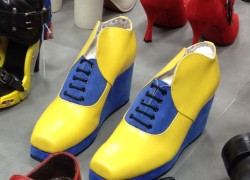
ART & DESIGN
NGV Teens: Shoes Glorious Shoes
National Gallery of Victoria
Review by Maria Dunne
Katie Somerville, a senior curator at the National Gallery of Victoria, and acclaimed shoemaker Claire Best, showed 13 teenagers from across Victoria just how fascinating shoes can really be. Together they revealed 30 different types of shoes that range from the year 1770 to 2015.
This is the second time the NGV have worked with VAMFF to create these behind-the-scenes workshops for teenagers and through it teenagers are able to explore the historical and artistic elements of the NGV Collection.
“Each shoe encapsulates a story” said Somerville.
Both women were drawn to looking at shoes. Claire Best said one of the things that made her love shoemaking was meeting shoemakers and just “picking up a cup of coffee and a life story”.
Although at first the girls at the seminar were daunted by the wide collection of shoes that was positioned in front of them, they began asking questions and expressing their admiration of the colours, textures and array of shapes these shoes came in.
Highlights included the Thea Cadabra dragon-inspired 1979 shoe, the aristocratic noblemen 1770 shoe, the 2011 Nike trainer and my personal favourite, Simon O’Mallon’s 1997 Dawn.
Many were surprised that the Thea Cadabra shoe was made in the 70s, but this shoe has a fascinating history and an amazing craftsmanship behind it. It was inspired by David Bowie’s Ziggy Stardust persona and many other extravagant theatrical conventions. These Chinese dragon Shoes have more than 100 pattern pieces that were individually sewn on.
Similarly, many were surprised to find the shoes from the 1770s were straight shoes that did not distinctly have a left or right foot. It was made out of kid leather which seemed appropriate considering how small the shoe was.
This behind-the-scenes adventure was full of excitement and curiosity. As shoes went around the room, the scent of the leather automatically made everyone smile and stare at the sheer beauty of them. Getting up close and personal with these shoes not normally seen by the public had a certain coolness to it, due to the fact that we were seeing things only a few people had seen before.
After exploring the shoes, a talk lead by Claire Best explained the effort it takes to make a shoe by hand. Passing around her tools and shoe prototypes we could see why Claire found the whole experience “romantic”, yet some girls were put off by her use of real cow and kangaroo leather. We can all agree however that this art form will not be lost by amazing shoemakers like Claire, as her technique and determination are both highly admirable.

